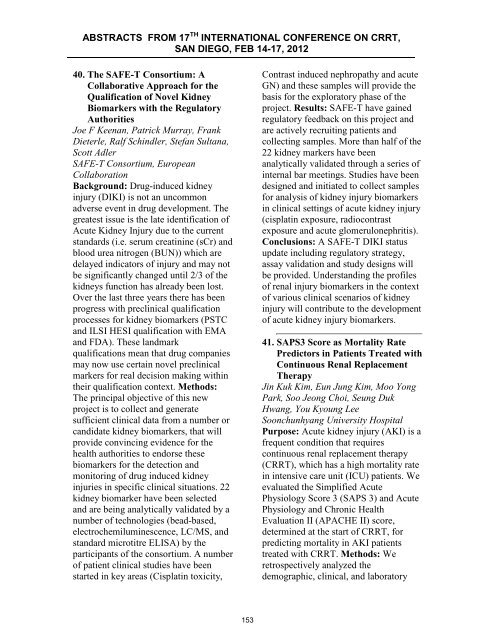ABSTRACTS from 16th International COnference on ... - CRRT Online
ABSTRACTS from 16th International COnference on ... - CRRT Online
ABSTRACTS from 16th International COnference on ... - CRRT Online
Create successful ePaper yourself
Turn your PDF publications into a flip-book with our unique Google optimized e-Paper software.
<str<strong>on</strong>g>ABSTRACTS</str<strong>on</strong>g> FROM 17 TH INTERNATIONAL CONFERENCE ON <strong>CRRT</strong>,<br />
SAN DIEGO, FEB 14-17, 2012<br />
40. The SAFE-T C<strong>on</strong>sortium: A<br />
Collaborative Approach for the<br />
Qualificati<strong>on</strong> of Novel Kidney<br />
Biomarkers with the Regulatory<br />
Authorities<br />
Joe F Keenan, Patrick Murray, Frank<br />
Dieterle, Ralf Schindler, Stefan Sultana,<br />
Scott Adler<br />
SAFE-T C<strong>on</strong>sortium, European<br />
Collaborati<strong>on</strong><br />
Background: Drug-induced kidney<br />
injury (DIKI) is not an uncomm<strong>on</strong><br />
adverse event in drug development. The<br />
greatest issue is the late identificati<strong>on</strong> of<br />
Acute Kidney Injury due to the current<br />
standards (i.e. serum creatinine (sCr) and<br />
blood urea nitrogen (BUN)) which are<br />
delayed indicators of injury and may not<br />
be significantly changed until 2/3 of the<br />
kidneys functi<strong>on</strong> has already been lost.<br />
Over the last three years there has been<br />
progress with preclinical qualificati<strong>on</strong><br />
processes for kidney biomarkers (PSTC<br />
and ILSI HESI qualificati<strong>on</strong> with EMA<br />
and FDA). These landmark<br />
qualificati<strong>on</strong>s mean that drug companies<br />
may now use certain novel preclinical<br />
markers for real decisi<strong>on</strong> making within<br />
their qualificati<strong>on</strong> c<strong>on</strong>text. Methods:<br />
The principal objective of this new<br />
project is to collect and generate<br />
sufficient clinical data <str<strong>on</strong>g>from</str<strong>on</strong>g> a number or<br />
candidate kidney biomarkers, that will<br />
provide c<strong>on</strong>vincing evidence for the<br />
health authorities to endorse these<br />
biomarkers for the detecti<strong>on</strong> and<br />
m<strong>on</strong>itoring of drug induced kidney<br />
injuries in specific clinical situati<strong>on</strong>s. 22<br />
kidney biomarker have been selected<br />
and are being analytically validated by a<br />
number of technologies (bead-based,<br />
electrochemiluminescence, LC/MS, and<br />
standard microtitre ELISA) by the<br />
participants of the c<strong>on</strong>sortium. A number<br />
of patient clinical studies have been<br />
started in key areas (Cisplatin toxicity,<br />
C<strong>on</strong>trast induced nephropathy and acute<br />
GN) and these samples will provide the<br />
basis for the exploratory phase of the<br />
project. Results: SAFE-T have gained<br />
regulatory feedback <strong>on</strong> this project and<br />
are actively recruiting patients and<br />
collecting samples. More than half of the<br />
22 kidney markers have been<br />
analytically validated through a series of<br />
internal bar meetings. Studies have been<br />
designed and initiated to collect samples<br />
for analysis of kidney injury biomarkers<br />
in clinical settings of acute kidney injury<br />
(cisplatin exposure, radioc<strong>on</strong>trast<br />
exposure and acute glomerul<strong>on</strong>ephritis).<br />
C<strong>on</strong>clusi<strong>on</strong>s: A SAFE-T DIKI status<br />
update including regulatory strategy,<br />
assay validati<strong>on</strong> and study designs will<br />
be provided. Understanding the profiles<br />
of renal injury biomarkers in the c<strong>on</strong>text<br />
of various clinical scenarios of kidney<br />
injury will c<strong>on</strong>tribute to the development<br />
of acute kidney injury biomarkers.<br />
41. SAPS3 Score as Mortality Rate<br />
Predictors in Patients Treated with<br />
C<strong>on</strong>tinuous Renal Replacement<br />
Therapy<br />
Jin Kuk Kim, Eun Jung Kim, Moo Y<strong>on</strong>g<br />
Park, Soo Je<strong>on</strong>g Choi, Seung Duk<br />
Hwang, You Kyoung Lee<br />
So<strong>on</strong>chunhyang University Hospital<br />
Purpose: Acute kidney injury (AKI) is a<br />
frequent c<strong>on</strong>diti<strong>on</strong> that requires<br />
c<strong>on</strong>tinuous renal replacement therapy<br />
(<strong>CRRT</strong>), which has a high mortality rate<br />
in intensive care unit (ICU) patients. We<br />
evaluated the Simplified Acute<br />
Physiology Score 3 (SAPS 3) and Acute<br />
Physiology and Chr<strong>on</strong>ic Health<br />
Evaluati<strong>on</strong> II (APACHE II) score,<br />
determined at the start of <strong>CRRT</strong>, for<br />
predicting mortality in AKI patients<br />
treated with <strong>CRRT</strong>. Methods: We<br />
retrospectively analyzed the<br />
demographic, clinical, and laboratory<br />
153
















